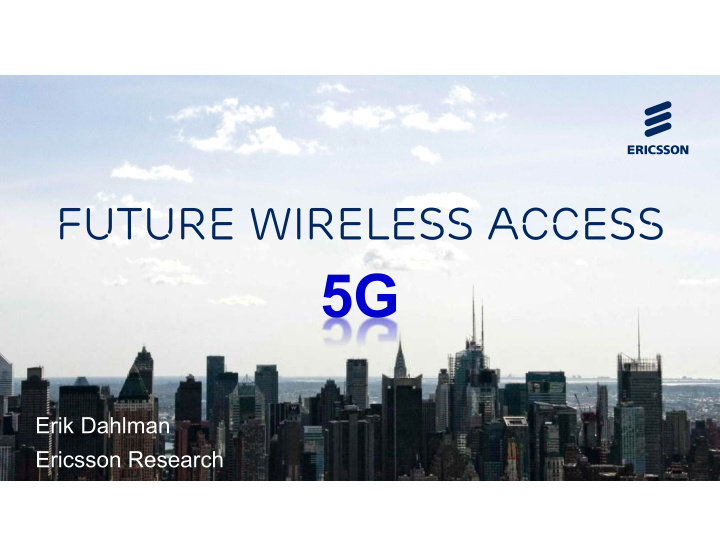



���������������������� �� Erik Dahlman Ericsson Research
������������������������ �� A Heterogeneous Network Technology Use cases • High�quality mobile broadband ������������ • Billions of sensors • Critical communication for infra�structure, traffic safety, medical applications, ) • Smart homes, education, ) • ) Spectrum Deployment • Wide�area to local�area • Outdoor and Indoor • Public, enterprise, residential, ) • Sub�GHz to mmw • Different duplex arrangements • Different spectrum regimes CTW 2014 | Ericsson Proprietary Information | 2014�05�26 | Page 2
���������������������� A wide range of requirements ����������������� ��������������� �������������� ���������������� ���������� �������� ���������� ��������������� �������� ���������������������� ������������������ ����������� �������������������������� CTW 2014 | Ericsson Proprietary Information | 2014�05�26 | Page 3
�������� Spectrum range relevant for 5G networks ����� ����� ������ ������ ������� › Lower frequencies for full area coverage › Complementary use of higher frequencies Extreme capacity and data rates � For extreme capacity and data rates in dense scenarios Coverage CTW 2014 | Ericsson Proprietary Information | 2014�05�26 | Page 4
������������������ FDD dominating in lower (licensed) bands TDD more relevant for higher bands targeting very wide bandwidths in dense deployments � Coverage benefits � Easier to find unpaired spectrum � Avoids some nasty interference situations (BS � BS, device � device) � Access nodes and devices becoming more similar � More dynamic traffic variations ����� ����� ������ ������ ������� Full duplex may eventually be introduced Dynamic assignment of downlink/uplink resources On link level ) ) or only on system level Simultaneous TX/RX on same frequency CTW 2014 | Ericsson Proprietary Information | 2014�05�26 | Page 5
������������������� ��������������������������� ���������������� Will remain the backbone of IMT › Becoming more relevant for very wide bandwidths in dense deployments � Controlled interference � “Guaranteed” quality � Difficult to find dedicated spectrum for multiple operators � Efficient at high load � More dynamic traffic variations › Complemented by unlicensed spectrum � To get access to more spectrum � WiFi or unlicensed LTE › Unlicensed › Shared licensed spectrum › What about network sharing? CTW 2014 | Ericsson Proprietary Information | 2014�05�26 | Page 6
������������������������ ! ����������������������������������� › For both low and high frequencies › Multi�antenna TX/RX extended to multiple sites › Beam forming for coverage › Multi�user MIMO for capacity ������������������������ › RRC connectivity to overlaid layer › Robust mobility for (ultra) dense deployments CTW 2014 | Ericsson Proprietary Information | 2014�05�26 | Page 7
"����#����� ���������� › Networks lightly loaded on average › ����������������������������������������������� › Will not change dramatically in the future � Much more traffic but also much more network nodes › Minimize broadcast of system information � Main part provided on a per�need basis !�������"����#��������� $���������%� › Separate user�data plane from system information � System information broadcast wide�area � Underlaid nodes only active when user�data to convey › Network transmissions not related to user data � Reference signals, system information, )’ � ����������������������������������������� � �������������������������������������������� ���������������������������� !������������������������� CTW 2014 | Ericsson Proprietary Information | 2014�05�26 | Page 8
$��%���� !������&��'���������������� (����)� Massive use of wireless backhaul � P2P mmW line�of�sight links to macro sites using › Same technology for access and backhaul dedicated technology in dedicated spectrum › Same spectrum for access and backhaul � mmw bands as well as lower frequencies (������*)� Large number of low�power nodes � Targeting very high data rates � Indoor and outdoor › Do not distinguish between access and backhaul � "���������������#�������� � Get from point A to B without a wire CTW 2014 | Ericsson Proprietary Information | 2014�05�26 | Page 9
��&�������#�&����������������� Already in LTE +�,������-��� ".���������#������������� Social media Advertising Proximity detection Communication ������������������������������ ����������������������������� Why D2D? CTW 2014 | Ericsson Proprietary Information | 2014�05�26 | Page 10
��&�������#�&����������������� "(����# "(������*# $���������%������������&�' $���������%������&�' CTW 2014 | Ericsson Proprietary Information | 2014�05�26 | Page 11
'�������������&�(�#�&����) › Maybe one should not differ between “base stations” and “devices” ) ) but rather between “high�power” nodes and “low�power” nodes › Maybe one should not differ between downlink spectrum and uplink spectrum ) ) but rather between “high�power” spectrum and ”low�power” spectrum? › Maybe there should just be different types of “devices” communication with each other? � Some devices move around, some do not! � Some devices provide wired connectivity, some do not! � Some devices “belong” to operators, some do not! � ) Or maybe not? CTW 2014 | Ericsson Proprietary Information | 2014�05�26 | Page 12
���������� CTW 2014 | Ericsson Proprietary Information | 2014�05�26 | Page 13
Recommend
More recommend